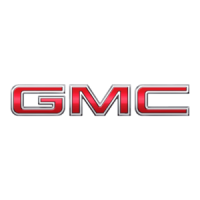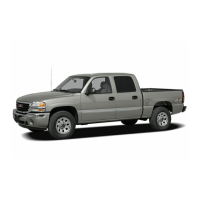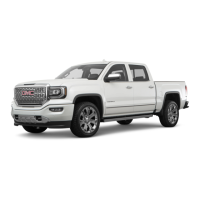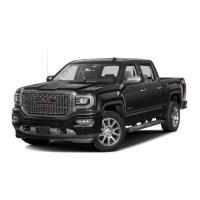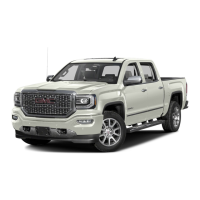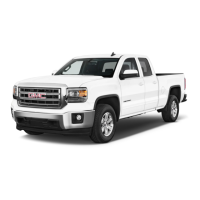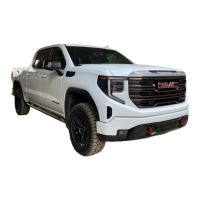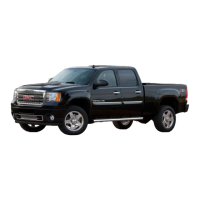Do you have a question about the GMC SIERRA DENALI 2003 and is the answer not in the manual?
Describes adjustment controls for front seats, including power and lumbar features.
Explains how to fold and operate rear seats for cargo or seating space.
Details how to wear safety belts properly, including for pregnant women and children.
Covers proper use of safety belts and child restraint systems for older children and infants.
Explains how air bags work, their limitations, and crucial safety precautions.
Guidance on checking safety belts and air bag systems for proper function and condition.
Information about the vehicle's key and preventing theft by securing keys.
Details operation, range, and functions of the remote keyless entry system.
Explains manual and power door lock operation, child safety, and security measures.
Information on power windows, express-down features, and swing-out rear windows.
Describes the content theft-deterrent alarm system activation and Passlock® operation.
Covers new vehicle break-in, ignition positions, starting the engine, and retained accessory power.
Details automatic dimming rearview mirror, compass, temperature display, and outside mirrors.
Overview of OnStar services, including GPS, communication, and available features.
Explains programming and using the HomeLink universal transmitter for garage doors and gates.
Describes the location and use of storage compartments like the glove box and console.
Covers memory seat, mirror, and radio presets, and personalization options via the DIC.
Diagram identifying main components of the instrument panel and steering column controls.
Operation of hazard warning flashers and other warning devices for signaling.
Instructions on how to sound the vehicle's horn by pressing the center pad.
Adjusting the steering wheel position for driver comfort and ease of entry/exit.
Operation of turn signals, lane changes, headlamp controls, and wipers.
Controls for parking lamps, headlights, fog lamps, and automatic headlamp system.
Controls for dome lamps, exit lighting, entry lighting, and instrument panel brightness.
How to use power outlets for accessories like phones and other electrical devices.
Location and safe usage procedures for the ashtray and cigarette lighter.
Operation of the dual automatic climate control system for heating, cooling, and ventilation.
Explanation of the meaning and function of various warning lights and gages on the instrument panel.
Overview of the instrument panel cluster layout, including speedometer and tachometer.
How to read the speedometer, odometer, trip odometer, and engine hour meter.
Explanation of the function and operation of the tachometer.
Function and operation of the safety belt reminder light and chime.
Explains the air bag readiness light and system checks for malfunctions.
Indicates when the right front passenger's air bag has been turned off.
Explains the passenger air bag status indicator in the rearview mirror.
Indicates a potential problem with the vehicle's charging system.
Shows the battery's state of charge and charging system condition.
Warns of potential issues with the hydraulic or anti-lock brake systems.
Indicates a problem with the anti-lock brake system and requires service.
Displays the engine coolant temperature and indicates operating load.
Shows the transmission fluid temperature and potential overheating.
Signals a problem with engine, ignition, or emission control systems, requiring service.
Displays vehicle info like trip data, fuel economy, personalization, and warnings.
How to navigate and use the DIC display, including modes and button functions.
Accessing and resetting trip odometers, timers, logs, and other trip data via the DIC.
Checking fuel range, average fuel economy, instant fuel economy, and GM Oil Life System status.
Customizing vehicle features like alarm warnings, auto locking, and lighting via the DIC.
Setting how the vehicle alerts for alarm activation (horn, lights, or both).
Configuring automatic door locking based on gear selection or vehicle speed.
Setting when doors automatically unlock (in Park, key out, or manually).
Recalling stored seat, mirror, and radio presets using memory buttons or key.
Configuring the driver's seat to move to an exit position automatically.
Selecting display units between English (miles, MPG) and Metric.
Choosing the display language for the Driver Information Center (DIC).
Resets functions, acknowledges messages, and toggles DIC options.
Notifies driver of vehicle status changes and required actions via DIC messages.
General advice on safe driving practices, including defensive driving and hazard awareness.
The severe dangers and consequences of driving under the influence of alcohol.
Understanding the three systems (brakes, steering, accelerator) that control vehicle movement.
Explains perception time, reaction time, stopping distances, and emergency braking.
How ABS works to prevent braking skids and improve stability during hard stops.
Provides additional traction on slippery surfaces by locking the rear axle.
Tips for driving on curves, steering in emergencies, and power steering operation.
Operation and driving modes of the four-wheel steer system.
Guidance on using car washes safely with QUADRASTEER™ vehicles.
Instructions on how to recover a vehicle that has driven off the road shoulder.
Safe techniques and essential tips for passing other vehicles on highways.
Explains types of skids and how to handle them by adjusting accelerator and steering.
Guidelines for driving AWD vehicles on unpaved surfaces and terrain.
Proper techniques for loading cargo for off-road conditions to ensure stability.
Basic rules for protecting the environment during off-road driving activities.
Tips for planning and traveling safely to remote locations, including vehicle preparation.
Practicing off-road driving skills and understanding vehicle feedback and controls.
Considering surface conditions and obstacles for safe off-road navigation.
Identifying and handling unseen or hidden obstacles encountered off-road.
Judgment and techniques for safely driving up, down, or across off-road hills.
Factors to consider when approaching an off-road hill, assessing steepness and conditions.
Special steps and precautions for safely driving uphill off-road.
Actions to take if the vehicle stalls or cannot climb a hill, including must-dos and don'ts.
Considerations and techniques for driving downhill off-road to maintain control.
Prohibited actions and risks to avoid when driving downhill to prevent accidents.
Advice on what to do if the vehicle stalls while going downhill.
Risks and considerations for driving across inclines off-road, including rollover potential.
How to handle sliding sideways on an incline, and tips for preventing it.
Safety precautions if the vehicle stalls while on an incline, especially regarding exiting.
Techniques for maintaining traction and control when driving in challenging low-traction conditions.
Precautions and dangers of driving through water, flood conditions, and potential vehicle damage.
Post-off-road checks for debris, brake inspection, and overall vehicle condition.
Tips for safe driving during nighttime, including visibility and driver fatigue awareness.
Adjusting driving for wet conditions, hydroplaning risks, and wiper maintenance.
Understanding the causes and prevention of hydroplaning on wet roads.
Extreme caution and risks associated with driving through flowing or standing water.
Strategies for increasing safety and efficiency in city driving, focusing on traffic and signals.
Rules and advice for driving safely on freeways, including merging and lane changes.
Pre-trip checks and preparations for ensuring vehicle readiness and safety for long journeys.
Recognizing and preventing driver fatigue or inattentiveness on monotonous roads.
Differences and challenges of driving on steep or mountainous terrain, including grades.
Tips for preparing the vehicle and driving safely in winter conditions, including emergency supplies.
Techniques for maintaining traction and control on snow and ice surfaces.
Safety measures and advice for surviving if stranded by heavy snow.
Methods for freeing a stuck vehicle by rocking or using recovery hooks.
Step-by-step guide to freeing a stuck vehicle using the rocking motion method.
Proper use of vehicle recovery hooks for off-road situations and safety warnings.
General advice and considerations for towing vehicles and trailers safely.
Information on tire labels, GVWR, GAWR, and safe cargo loading.
Advice on choosing appropriate hitches, sway controls, and trailer brakes for safe towing.
Information for owners considering body modifications and safety implications.
How the tow/haul mode assists when pulling heavy trailers or loads.
Determining safe trailer weights and calculating load capacities based on vehicle model.
Ensuring proper tire inflation and not exceeding weight limits for vehicle safety.
Importance of correct hitch equipment and rules for safe towing, considering crosswinds and roads.
Proper attachment and use of safety chains for trailers to prevent tongue contact with the road.
Requirements and proper installation, adjustment, and maintenance of trailer brake systems.
Experience and checks needed for safe trailering, including handling and braking.
Maintaining adequate following distance when towing a trailer to avoid hazards.
Adjusting turning radius and avoiding sharp turns while trailering to prevent contact.
Techniques for backing up a trailer, including using four-wheel steering.
Ensuring trailer lights function correctly when signaling turns or lane changes.
Techniques for safely driving uphill and downhill, including gear selection and brake use.
Procedures for safely parking a vehicle with a trailer on inclines, using chocks.
Steps for safely departing after parking on a hill, ensuring vehicle is secured.
Increased maintenance needs for vehicles used for towing, focusing on fluids and tires.
Recommends using genuine GM parts and dealer service for optimal vehicle maintenance.
Guidance on performing DIY service, emphasizing safety, proper tools, and record-keeping.
Potential effects of external accessories on vehicle aerodynamics, noise, and washer performance.
Information on recommended gasoline octane, specifications, and additives for optimal performance.
Recommended octane rating and effects of lower octane fuel, including engine knocking.
Recommended gasoline specifications for better vehicle performance and engine protection.
Specific fuel requirements for vehicles certified for California emissions standards.
Information on mandated fuel additives and warnings against using methanol or MMT.
Advice on fuel availability and types when driving internationally, and warranty implications.
Safe procedures and precautions for refueling the vehicle, including fuel vapor hazards.
Safety guidelines for filling portable fuel containers, emphasizing static discharge prevention.
General safety precautions and location of the hood release lever.
Step-by-step instructions on how to open the vehicle's hood.
Diagram identifying key components located in the engine compartment.
Checking engine oil level, when to add oil, and using the correct oil types.
Step-by-step guide to accurately checking engine oil level using the dipstick.
Guidance on how much oil to add and potential damage from overfilling.
Identifying and selecting the correct engine oil based on API certification and viscosity.
Advice against using oil additives; recommended oils meet starburst symbol requirements.
How the GM Oil Life System indicates when to change engine oil and filter.
Procedures for resetting the oil life system after an oil change.
Proper disposal and environmental considerations for used engine oil.
Indicator for air filter service and location of the assembly.
Step-by-step instructions for replacing the engine air cleaner/filter and safety warnings.
When to check and change automatic transmission fluid and filter based on driving conditions.
Procedures for checking transmission fluid level accurately, noting temperature effects.
Detailed steps for checking transmission fluid with engine warm or cold.
Guidance on adding transmission fluid, including using DEXRON® III and avoiding overfilling.
Information on DEX-COOL® coolant, mixture, and freezing/boiling protection.
Importance of using the correct coolant mixture and warnings about plain water or alcohol.
How to check coolant level in the surge tank and safety precautions regarding hot systems.
Steps for adding coolant to the surge tank when the engine is cool.
Importance of proper installation and safety warnings for the pressure cap.
Explains coolant temperature gauge, DIC messages, and overheat protection mode.
Safety precautions and actions to take when steam is visible from the engine.
What to do if an overheat warning occurs without visible steam, including engine checks.
Overview of cooling system components and coolant level check.
Explanation of normal engine fan noise related to clutch engagement and cooling system function.
When to check, how to check, and what fluid to use for the power steering system.
What to use, how to add fluid, and precautions for washer fluid, including freezing.
Information on brake fluid, its importance, and cautions regarding spills and usage.
Explains the role of brake fluid, reasons for level changes, and effects of improper fluid.
How to check brake fluid level in the reservoir without removing the cap.
Using only DOT-3 brake fluid from a sealed container and cleaning procedures.
Identifying worn brake pads via warning sounds and proper replacement procedures.
Signs of brake trouble related to pedal height, travel, and adjustment.
Information on the maintenance-free ACDelco® battery and handling precautions.
How to prepare the vehicle for storage of 25 days or more to preserve battery life.
Step-by-step guide and safety precautions for jump-starting a vehicle with another vehicle.
Procedures for safely disconnecting jumper cables from both vehicles.
Explanation of how the AWD system works and lubricant checks for transfer case.
Guidance on when to check and what lubricant to use for the transfer case.
Checking lubricant level and type for the rear axle and QUADRASTEER™ system.
Checking lubricant level and type for the front axle differential.
General guidance on bulb replacement and safety precautions for halogen bulbs.
Procedure for replacing headlamp bulbs, including low and high beams.
Procedure for replacing bulbs for front turn signals, sidemarkers, and DRLs.
Procedure for replacing bulbs in the center roof marker lamps.
Procedure for replacing bulbs for the CHMSL and cargo lamps.
Procedure for replacing bulbs for pickup box and fender marker lamps.
Procedure for replacing taillamp bulbs, including opening the tailgate.
A table listing exterior bulb types and their corresponding part numbers.
Steps for inspecting and replacing windshield wiper blades.
General information on tire maintenance, safety precautions, and common issues.
Importance of correct tire inflation and checking pressure when tires are cold.
Procedures for tire inspection, rotation intervals, and wheel nut tightening.
Identifying signs that indicate the need for new tires, such as treadwear indicators.
How to choose the correct tire size and type, including TPC Spec number.
Explanation of tire grading systems: Treadwear, Traction, and Temperature.
When wheel alignment or balancing may be necessary due to tire wear or vibration.
Guidelines for replacing wheels, bolts, nuts, and using GM original equipment parts.
Warnings against using used wheels due to safety risks and potential failure.
Warnings about tire chain clearance, potential damage, and proper use of traction devices.
What to do if a tire blows out or leaks air slowly, including steering and braking.
Step-by-step instructions and safety precautions for changing a flat tire.
How to access and remove the spare tire and associated tools from under the vehicle.
Explanation of the secondary latch system for spare tire hoisting and installation requirements.
Proper storage procedures for flat tires, spare tires, and tools within the vehicle.
Overview of the maintenance schedule, its importance, and relationship to vehicle condition.
Purpose of the maintenance schedule and its role in vehicle upkeep and environmental protection.
Importance of proper maintenance for vehicle condition and minimizing emissions.
Necessity of following recommended maintenance for warranty coverage and vehicle condition.
Breakdown of the maintenance schedule into five parts: Services, Checks, Inspections, Fluids, and Record.
Explains services and intervals for engine oil, chassis lubrication, and mileage-based maintenance.
How to use the schedule effectively based on driving habits and conditions.
Detailed services up to 100,000 miles, including engine oil, filter, and chassis lubrication.
Owner checks at fuel fill, monthly, and semi-annually for safety, dependability, and performance.
Checks to perform every time you refuel, like engine oil and coolant levels.
Instructions on how to check and add engine oil correctly.
How to check engine coolant level and add DEX-COOL® coolant if necessary.
Checking and adding windshield washer fluid, with precautions for cold weather.
Monthly checks including tire inflation, spare tire check, and cassette tape player cleaning.
Importance of checking tire pressure regularly, including the spare tire.
Recommended cleaning intervals for the cassette tape player to maintain sound quality.
Semi-annual checks for restraint systems, wiper blades, spare tire, and weatherstrips.
Checking safety belts, air bag covers, retractors, and anchorages for proper function.
Inspecting wiper blades for wear, cracking, and cleaning them for optimal performance.
Ensuring the spare tire is securely stored and properly inflated.
Lubricating weatherstrips with silicone grease for longevity, sealing, and preventing squeaks.
Checking automatic transmission fluid level and addressing potential fluid loss.
Annual services including key lock cylinder lubrication and body lubrication points.
Lubricating the key lock cylinders with the specified lubricant.
Lubricating various body components like hinges, latches, and pivot points.
Verifying the starter operates correctly only in PARK (P) or NEUTRAL (N) gears.
Checking the transmission shift lock mechanism to ensure it prevents movement out of PARK.
Ensuring the ignition key can only be turned to LOCK when the shift lever is in PARK (P).
Checking parking brake holding ability and transmission park mechanism engagement.
Flushing corrosive materials from the underbody annually with plain water.
Inspections recommended for dealer or qualified service center, covering key vehicle systems.
Inspecting suspension and steering components for damage, wear, or lubrication issues.
Inspecting the exhaust system and surrounding body for damage, leaks, or heat issues.
Inspecting the complete fuel system for any signs of damage or leaks.
Inspecting hoses, pipes, clamps, and performing pressure tests for cooling system integrity.
Checking lubricant levels and seals for AWD components like transfer case and front axle.
Inspecting brake lines, hoses, pads, rotors, calipers, and parking brake for wear.
Lists recommended fluids, lubricants, their part numbers, and usage details.
A log for recording service dates, odometer readings, and performed maintenance.
Overview of customer assistance resources and contact information.
Step-by-step process for addressing concerns with dealers or GMC.
Resource for vehicle info, service reminders, maintenance schedules, and dealer locators.
Contact information for TTY users needing assistance via Text Telephone.
Mailing addresses for customer assistance centers in the United States, Canada, and overseas.
Program for reimbursement of adaptive equipment for disabled drivers.
Details on services like flat tire change, fuel delivery, jump starts, lockout, and towing.
Options for transportation assistance during warranty repairs, such as shuttle service.
Advice on scheduling service appointments to minimize inconvenience.
How to report vehicle safety defects to the National Highway Traffic Safety Administration (NHTSA).
How to report vehicle safety defects to Transport Canada.
How to report safety defects directly to GMC Customer Assistance.
Information on how to order service manuals and owner publications.
Describes adjustment controls for front seats, including power and lumbar features.
Explains how to fold and operate rear seats for cargo or seating space.
Details how to wear safety belts properly, including for pregnant women and children.
Covers proper use of safety belts and child restraint systems for older children and infants.
Explains how air bags work, their limitations, and crucial safety precautions.
Guidance on checking safety belts and air bag systems for proper function and condition.
Information about the vehicle's key and preventing theft by securing keys.
Details operation, range, and functions of the remote keyless entry system.
Explains manual and power door lock operation, child safety, and security measures.
Information on power windows, express-down features, and swing-out rear windows.
Describes the content theft-deterrent alarm system activation and Passlock® operation.
Covers new vehicle break-in, ignition positions, starting the engine, and retained accessory power.
Details automatic dimming rearview mirror, compass, temperature display, and outside mirrors.
Overview of OnStar services, including GPS, communication, and available features.
Explains programming and using the HomeLink universal transmitter for garage doors and gates.
Describes the location and use of storage compartments like the glove box and console.
Covers memory seat, mirror, and radio presets, and personalization options via the DIC.
Diagram identifying main components of the instrument panel and steering column controls.
Operation of hazard warning flashers and other warning devices for signaling.
Instructions on how to sound the vehicle's horn by pressing the center pad.
Adjusting the steering wheel position for driver comfort and ease of entry/exit.
Operation of turn signals, lane changes, headlamp controls, and wipers.
Controls for parking lamps, headlights, fog lamps, and automatic headlamp system.
Controls for dome lamps, exit lighting, entry lighting, and instrument panel brightness.
How to use power outlets for accessories like phones and other electrical devices.
Location and safe usage procedures for the ashtray and cigarette lighter.
Operation of the dual automatic climate control system for heating, cooling, and ventilation.
Explanation of the meaning and function of various warning lights and gages on the instrument panel.
Overview of the instrument panel cluster layout, including speedometer and tachometer.
How to read the speedometer, odometer, trip odometer, and engine hour meter.
Explanation of the function and operation of the tachometer.
Function and operation of the safety belt reminder light and chime.
Explains the air bag readiness light and system checks for malfunctions.
Indicates when the right front passenger's air bag has been turned off.
Explains the passenger air bag status indicator in the rearview mirror.
Indicates a potential problem with the vehicle's charging system.
Shows the battery's state of charge and charging system condition.
Warns of potential issues with the hydraulic or anti-lock brake systems.
Indicates a problem with the anti-lock brake system and requires service.
Displays the engine coolant temperature and indicates operating load.
Shows the transmission fluid temperature and potential overheating.
Signals a problem with engine, ignition, or emission control systems, requiring service.
Displays vehicle info like trip data, fuel economy, personalization, and warnings.
How to navigate and use the DIC display, including modes and button functions.
Accessing and resetting trip odometers, timers, logs, and other trip data via the DIC.
Checking fuel range, average fuel economy, instant fuel economy, and GM Oil Life System status.
Customizing vehicle features like alarm warnings, auto locking, and lighting via the DIC.
Setting how the vehicle alerts for alarm activation (horn, lights, or both).
Configuring automatic door locking based on gear selection or vehicle speed.
Setting when doors automatically unlock (in Park, key out, or manually).
Recalling stored seat, mirror, and radio presets using memory buttons or key.
Configuring the driver's seat to move to an exit position automatically.
Selecting display units between English (miles, MPG) and Metric.
Choosing the display language for the Driver Information Center (DIC).
Resets functions, acknowledges messages, and toggles DIC options.
Notifies driver of vehicle status changes and required actions via DIC messages.
General advice on safe driving practices, including defensive driving and hazard awareness.
The severe dangers and consequences of driving under the influence of alcohol.
Understanding the three systems (brakes, steering, accelerator) that control vehicle movement.
Explains perception time, reaction time, stopping distances, and emergency braking.
How ABS works to prevent braking skids and improve stability during hard stops.
Provides additional traction on slippery surfaces by locking the rear axle.
Tips for driving on curves, steering in emergencies, and power steering operation.
Operation and driving modes of the four-wheel steer system.
Guidance on using car washes safely with QUADRASTEER™ vehicles.
Instructions on how to recover a vehicle that has driven off the road shoulder.
Safe techniques and essential tips for passing other vehicles on highways.
Explains types of skids and how to handle them by adjusting accelerator and steering.
Guidelines for driving AWD vehicles on unpaved surfaces and terrain.
Proper techniques for loading cargo for off-road conditions to ensure stability.
Basic rules for protecting the environment during off-road driving activities.
Tips for planning and traveling safely to remote locations, including vehicle preparation.
Practicing off-road driving skills and understanding vehicle feedback and controls.
Considering surface conditions and obstacles for safe off-road navigation.
Identifying and handling unseen or hidden obstacles encountered off-road.
Judgment and techniques for safely driving up, down, or across off-road hills.
Factors to consider when approaching an off-road hill, assessing steepness and conditions.
Special steps and precautions for safely driving uphill off-road.
Actions to take if the vehicle stalls or cannot climb a hill, including must-dos and don'ts.
Considerations and techniques for driving downhill off-road to maintain control.
Prohibited actions and risks to avoid when driving downhill to prevent accidents.
Advice on what to do if the vehicle stalls while going downhill.
Risks and considerations for driving across inclines off-road, including rollover potential.
How to handle sliding sideways on an incline, and tips for preventing it.
Safety precautions if the vehicle stalls while on an incline, especially regarding exiting.
Techniques for maintaining traction and control when driving in challenging low-traction conditions.
Precautions and dangers of driving through water, flood conditions, and potential vehicle damage.
Post-off-road checks for debris, brake inspection, and overall vehicle condition.
Tips for safe driving during nighttime, including visibility and driver fatigue awareness.
Adjusting driving for wet conditions, hydroplaning risks, and wiper maintenance.
Understanding the causes and prevention of hydroplaning on wet roads.
Extreme caution and risks associated with driving through flowing or standing water.
Strategies for increasing safety and efficiency in city driving, focusing on traffic and signals.
Rules and advice for driving safely on freeways, including merging and lane changes.
Pre-trip checks and preparations for ensuring vehicle readiness and safety for long journeys.
Recognizing and preventing driver fatigue or inattentiveness on monotonous roads.
Differences and challenges of driving on steep or mountainous terrain, including grades.
Tips for preparing the vehicle and driving safely in winter conditions, including emergency supplies.
Techniques for maintaining traction and control on snow and ice surfaces.
Safety measures and advice for surviving if stranded by heavy snow.
Methods for freeing a stuck vehicle by rocking or using recovery hooks.
Step-by-step guide to freeing a stuck vehicle using the rocking motion method.
Proper use of vehicle recovery hooks for off-road situations and safety warnings.
General advice and considerations for towing vehicles and trailers safely.
Information on tire labels, GVWR, GAWR, and safe cargo loading.
Advice on choosing appropriate hitches, sway controls, and trailer brakes for safe towing.
Information for owners considering body modifications and safety implications.
How the tow/haul mode assists when pulling heavy trailers or loads.
Determining safe trailer weights and calculating load capacities based on vehicle model.
Ensuring proper tire inflation and not exceeding weight limits for vehicle safety.
Importance of correct hitch equipment and rules for safe towing, considering crosswinds and roads.
Proper attachment and use of safety chains for trailers to prevent tongue contact with the road.
Requirements and proper installation, adjustment, and maintenance of trailer brake systems.
Experience and checks needed for safe trailering, including handling and braking.
Maintaining adequate following distance when towing a trailer to avoid hazards.
Adjusting turning radius and avoiding sharp turns while trailering to prevent contact.
Techniques for backing up a trailer, including using four-wheel steering.
Ensuring trailer lights function correctly when signaling turns or lane changes.
Techniques for safely driving uphill and downhill, including gear selection and brake use.
Procedures for safely parking a vehicle with a trailer on inclines, using chocks.
Steps for safely departing after parking on a hill, ensuring vehicle is secured.
Increased maintenance needs for vehicles used for towing, focusing on fluids and tires.
Recommends using genuine GM parts and dealer service for optimal vehicle maintenance.
Guidance on performing DIY service, emphasizing safety, proper tools, and record-keeping.
Potential effects of external accessories on vehicle aerodynamics, noise, and washer performance.
Information on recommended gasoline octane, specifications, and additives for optimal performance.
Recommended octane rating and effects of lower octane fuel, including engine knocking.
Recommended gasoline specifications for better vehicle performance and engine protection.
Specific fuel requirements for vehicles certified for California emissions standards.
Information on mandated fuel additives and warnings against using methanol or MMT.
Advice on fuel availability and types when driving internationally, and warranty implications.
Safe procedures and precautions for refueling the vehicle, including fuel vapor hazards.
Safety guidelines for filling portable fuel containers, emphasizing static discharge prevention.
General safety precautions and location of the hood release lever.
Step-by-step instructions on how to open the vehicle's hood.
Diagram identifying key components located in the engine compartment.
Checking engine oil level, when to add oil, and using the correct oil types.
Step-by-step guide to accurately checking engine oil level using the dipstick.
Guidance on how much oil to add and potential damage from overfilling.
Identifying and selecting the correct engine oil based on API certification and viscosity.
Advice against using oil additives; recommended oils meet starburst symbol requirements.
How the GM Oil Life System indicates when to change engine oil and filter.
Procedures for resetting the oil life system after an oil change.
Proper disposal and environmental considerations for used engine oil.
Indicator for air filter service and location of the assembly.
Step-by-step instructions for replacing the engine air cleaner/filter and safety warnings.
When to check and change automatic transmission fluid and filter based on driving conditions.
Procedures for checking transmission fluid level accurately, noting temperature effects.
Detailed steps for checking transmission fluid with engine warm or cold.
Guidance on adding transmission fluid, including using DEXRON® III and avoiding overfilling.
Information on DEX-COOL® coolant, mixture, and freezing/boiling protection.
Importance of using the correct coolant mixture and warnings about plain water or alcohol.
How to check coolant level in the surge tank and safety precautions regarding hot systems.
Steps for adding coolant to the surge tank when the engine is cool.
Importance of proper installation and safety warnings for the pressure cap.
Explains coolant temperature gauge, DIC messages, and overheat protection mode.
Safety precautions and actions to take when steam is visible from the engine.
What to do if an overheat warning occurs without visible steam, including engine checks.
Overview of cooling system components and coolant level check.
Explanation of normal engine fan noise related to clutch engagement and cooling system function.
When to check, how to check, and what fluid to use for the power steering system.
What to use, how to add fluid, and precautions for washer fluid, including freezing.
Information on brake fluid, its importance, and cautions regarding spills and usage.
Explains the role of brake fluid, reasons for level changes, and effects of improper fluid.
How to check brake fluid level in the reservoir without removing the cap.
Using only DOT-3 brake fluid from a sealed container and cleaning procedures.
Identifying worn brake pads via warning sounds and proper replacement procedures.
Signs of brake trouble related to pedal height, travel, and adjustment.
Information on the maintenance-free ACDelco® battery and handling precautions.
How to prepare the vehicle for storage of 25 days or more to preserve battery life.
Step-by-step guide and safety precautions for jump-starting a vehicle with another vehicle.
Procedures for safely disconnecting jumper cables from both vehicles.
Explanation of how the AWD system works and lubricant checks for transfer case.
Guidance on when to check and what lubricant to use for the transfer case.
Checking lubricant level and type for the rear axle and QUADRASTEER™ system.
Checking lubricant level and type for the front axle differential.
General guidance on bulb replacement and safety precautions for halogen bulbs.
Procedure for replacing headlamp bulbs, including low and high beams.
Procedure for replacing bulbs for front turn signals, sidemarkers, and DRLs.
Procedure for replacing bulbs in the center roof marker lamps.
Procedure for replacing bulbs for the CHMSL and cargo lamps.
Procedure for replacing bulbs for pickup box and fender marker lamps.
Procedure for replacing taillamp bulbs, including opening the tailgate.
A table listing exterior bulb types and their corresponding part numbers.
Steps for inspecting and replacing windshield wiper blades.
General information on tire maintenance, safety precautions, and common issues.
Importance of correct tire inflation and checking pressure when tires are cold.
Procedures for tire inspection, rotation intervals, and wheel nut tightening.
Identifying signs that indicate the need for new tires, such as treadwear indicators.
How to choose the correct tire size and type, including TPC Spec number.
Explanation of tire grading systems: Treadwear, Traction, and Temperature.
When wheel alignment or balancing may be necessary due to tire wear or vibration.
Guidelines for replacing wheels, bolts, nuts, and using GM original equipment parts.
Warnings against using used wheels due to safety risks and potential failure.
Warnings about tire chain clearance, potential damage, and proper use of traction devices.
What to do if a tire blows out or leaks air slowly, including steering and braking.
Step-by-step instructions and safety precautions for changing a flat tire.
How to access and remove the spare tire and associated tools from under the vehicle.
Explanation of the secondary latch system for spare tire hoisting and installation requirements.
Proper storage procedures for flat tires, spare tires, and tools within the vehicle.
Overview of the maintenance schedule, its importance, and relationship to vehicle condition.
Purpose of the maintenance schedule and its role in vehicle upkeep and environmental protection.
Importance of proper maintenance for vehicle condition and minimizing emissions.
Necessity of following recommended maintenance for warranty coverage and vehicle condition.
Breakdown of the maintenance schedule into five parts: Services, Checks, Inspections, Fluids, and Record.
Explains services and intervals for engine oil, chassis lubrication, and mileage-based maintenance.
How to use the schedule effectively based on driving habits and conditions.
Detailed services up to 100,000 miles, including engine oil, filter, and chassis lubrication.
Owner checks at fuel fill, monthly, and semi-annually for safety, dependability, and performance.
Checks to perform every time you refuel, like engine oil and coolant levels.
Instructions on how to check and add engine oil correctly.
How to check engine coolant level and add DEX-COOL® coolant if necessary.
Checking and adding windshield washer fluid, with precautions for cold weather.
Monthly checks including tire inflation, spare tire check, and cassette tape player cleaning.
Importance of checking tire pressure regularly, including the spare tire.
Recommended cleaning intervals for the cassette tape player to maintain sound quality.
Semi-annual checks for restraint systems, wiper blades, spare tire, and weatherstrips.
Checking safety belts, air bag covers, retractors, and anchorages for proper function.
Inspecting wiper blades for wear, cracking, and cleaning them for optimal performance.
Ensuring the spare tire is securely stored and properly inflated.
Lubricating weatherstrips with silicone grease for longevity, sealing, and preventing squeaks.
Checking automatic transmission fluid level and addressing potential fluid loss.
Annual services including key lock cylinder lubrication and body lubrication points.
Lubricating the key lock cylinders with the specified lubricant.
Lubricating various body components like hinges, latches, and pivot points.
Verifying the starter operates correctly only in PARK (P) or NEUTRAL (N) gears.
Checking the transmission shift lock mechanism to ensure it prevents movement out of PARK.
Ensuring the ignition key can only be turned to LOCK when the shift lever is in PARK (P).
Checking parking brake holding ability and transmission park mechanism engagement.
Flushing corrosive materials from the underbody annually with plain water.
Inspections recommended for dealer or qualified service center, covering key vehicle systems.
Inspecting suspension and steering components for damage, wear, or lubrication issues.
Inspecting the exhaust system and surrounding body for damage, leaks, or heat issues.
Inspecting the complete fuel system for any signs of damage or leaks.
Inspecting hoses, pipes, clamps, and performing pressure tests for cooling system integrity.
Checking lubricant levels and seals for AWD components like transfer case and front axle.
Inspecting brake lines, hoses, pads, rotors, calipers, and parking brake for wear.
Lists recommended fluids, lubricants, their part numbers, and usage details.
A log for recording service dates, odometer readings, and performed maintenance.
Overview of customer assistance resources and contact information.
Step-by-step process for addressing concerns with dealers or GMC.
Resource for vehicle info, service reminders, maintenance schedules, and dealer locators.
Contact information for TTY users needing assistance via Text Telephone.
Mailing addresses for customer assistance centers in the United States, Canada, and overseas.
Program for reimbursement of adaptive equipment for disabled drivers.
Details on services like flat tire change, fuel delivery, jump starts, lockout, and towing.
Options for transportation assistance during warranty repairs, such as shuttle service.
Advice on scheduling service appointments to minimize inconvenience.
How to report vehicle safety defects to the National Highway Traffic Safety Administration (NHTSA).
How to report vehicle safety defects to Transport Canada.
How to report safety defects directly to GMC Customer Assistance.
Information on how to order service manuals and owner publications.
| Brand | GMC |
|---|---|
| Model | SIERRA DENALI 2003 |
| Category | Automobile |
| Language | English |
